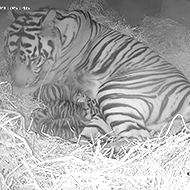
ZSL London Zoo announces arrival of rare Sumatran tigers.
Hidden cameras at ZSL London Zoo captured the exciting moment three Sumatran tiger cubs arrived, born on Monday 27 June.
In the early hours of the morning, keepers watched the live footage with bated breath as mum Gaysha gave birth to the cubs in her purpose-built cubbing den.
The births are a boost to the Sumatran tiger population, with the species classified as Critically Endangered. The smallest tiger subspecies, only an estimated 300 remain in the wild, with habitat loss, poaching and human-wildlife conflict contributing to the subspecies decline.
Mum Gaysha and dad Asim live in the zoo's Tiger Territory enclosure, which, with the help of the zoo's other Sumatran tigers, has welcomed eight new cubs.
Kathryn Sanders, tiger keeper at ZSL London Zoo, discussed the preparation needed to welcome the new additions: “We were confident that Gaysha was pregnant and had estimated roughly how far along she was - when we observed her stomach grow noticeably in the past few weeks, we knew she was nearing full-term.
“We prepared her a special indoor cubbing den, filled it with soft straw for comfort, and began a nightly vigil - monitoring her progress remotely on screen.”
All three cubs are reportedly doing well, and have already begun to feed and take their first wobbly steps. After their first set of vaccinations at three months old the cubs will be named, but until then, the special trio will growing and learning with minimal disturbance from keepers.
Kathryn added: “While we’re keeping a close eye via cubcam, we’re also taking care not to disturb the family so that they can continue to bond together - we can’t wait to get to know the little ones as they grow bigger and begin to explore their surroundings.”
Image (C) Zoological Society of London



 BSAVA is to partner with BVA Live (11-12 June 2026) to champion clinical research.
BSAVA is to partner with BVA Live (11-12 June 2026) to champion clinical research.